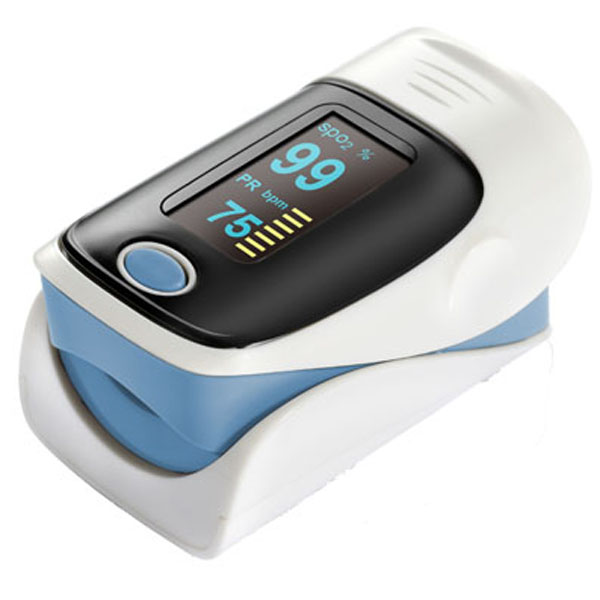In today's rapidly advancing healthcare landscape, fingertip oxygen monitors have become indispensable tools for healthcare professionals and individuals alike. Whether you're a healthcare provider or someone monitoring your health at home, understanding how to use these devices effectively is crucial. This guide provides a comprehensive overview of using a fingertip oxygen monitor, covering everything from initial setup to interpreting results.
Understanding Fingertip Oxygen Monitors
● Purpose and Function of Oximeters
Fingertip oxygen monitors, also known as pulse oximeters, are non-invasive devices designed to measure the oxygen saturation level in your blood (SpO2) and your heart rate. These devices are essential for detecting hypoxemia or inadequate levels of oxygen in the blood, which can be indicative of various medical conditions. They are widely used in hospitals, clinics, and homes to provide real-time monitoring of a patient's respiratory status.
● Components and Basic Operation
A typical fingertip oxygen monitor consists of a probe, often in the form of a clip, that is placed on a finger. Inside the probe, a light source emits two wavelengths of light through the fingertip. A detector measures the amount of light absorbed by hemoglobin, allowing the device to calculate the percentage of hemoglobin saturated with oxygen. The resulting SpO2 reading is displayed on a small screen alongside the heart rate.
Preparing for Accurate Readings
● Importance of Hand Position
To obtain the most reliable readings, it's essential to maintain proper hand positioning. The hand should be at the same level as your heart to ensure accurate measurement. Placing your hand on your chest can help achieve this alignment. Additionally, ensure your hand is warm and relaxed to promote optimal blood flow.
● Ensuring Stillness and Warmth
Stability is key when using a fingertip oxygen monitor. Movement can cause the device to provide erratic readings, so it's important to remain as still as possible during the measurement. Furthermore, cold hands can lead to inaccurate readings, as reduced blood flow may affect the monitor's ability to detect oxygen levels accurately.
Proper Device Placement
● Choosing the Right Finger, Earlobe, or Toe
While the finger is the most common placement for a fingertip oxygen monitor, the earlobe or toe can be used as alternatives. It's essential to select the site that provides the most accurate and consistent readings. Generally, the index or middle finger is preferred, but if circulation to these fingers is compromised, the earlobe or a toe may be used.
● Avoiding Common Placement Errors
Improper placement can lead to inaccurate readings. To avoid such errors, ensure the probe is securely attached to the fingertip and the sensor covers both the top and bottom of the finger. Avoid placing the probe on an uneven surface or over nail polish, as these factors can interfere with the light transmission and absorption process.
Initiating the Monitoring Process
● Starting the Oximeter
Once the device is properly placed, turn on the oximeter by pressing the power button. Most devices will automatically begin measuring SpO2 and heart rate. It's important to remain still and avoid speaking during this process, as movement can affect the results.
● Allowing Time for SpO2 Stabilization
It may take a few moments for the readings to stabilize. During this time, the device is calculating the average oxygen saturation level. Resist the urge to repeatedly check the display, as this can introduce movement and compromise the accuracy of the readings.
Interpreting Oximetry Waveforms
● Reading and Understanding Plethysmographs
In addition to displaying numerical values, many fingertip oxygen monitors include a plethysmograph or oximetry waveform. This graphical representation of blood flow provides additional context for interpreting readings. A well-defined waveform with rhythmic peaks and troughs indicates good circulation and a reliable reading.
● Correlating Waveform Quality with Accuracy
The quality of the plethysmograph can serve as a real-time indicator of measurement accuracy. A strong, consistent waveform suggests that the device is capturing accurate data, while erratic or poorly defined waveforms may signal the need for repositioning or further investigation.
Avoiding Common Errors
● Impact of Movement and Improper Placement
Movement is one of the most common sources of error when using a fingertip oxygen monitor. To obtain accurate readings, remain still and ensure the device is properly positioned. Additionally, avoid measuring SpO2 immediately after exercise, as this can result in fluctuations in blood flow and oxygen levels.
● Environmental Factors Affecting Readings
External factors such as ambient light, temperature, and altitude can impact the accuracy of oximeter readings. Using the device in a well-lit, temperature-controlled environment can minimize these influences. Additionally, individuals at high altitudes should be aware that lower baseline oxygen saturation levels are expected and not necessarily indicative of a medical issue.
Monitoring Duration and Frequency
● How Long to Keep the Device On
The duration of monitoring depends on the specific circumstances and the individual's health status. For routine checks, it may only be necessary to use the oximeter for a few minutes. However, in clinical or home monitoring scenarios, prolonged use may be warranted to track trends or assess treatment efficacy.
● Optimal Frequency of Checks in Different Situations
The frequency of oxygen saturation checks will vary based on individual needs and medical advice. Patients with chronic respiratory conditions may require regular monitoring, while healthy individuals may only need occasional checks, particularly during illness or physical exertion.
Dealing with Inconsistent Readings
● Identifying Potential Causes
When faced with inconsistent or unexpected readings, it's essential to troubleshoot potential causes. Common factors include movement, improper sensor placement, cold extremities, or interference from nail polish or artificial nails.
● Troubleshooting Tips and Tricks
To address inconsistent readings, ensure the device is correctly placed and the hand is warm. Remove any nail polish or artificial nails, and repeat the measurement. If issues persist, consider using a different finger or body site or consult the manufacturer's instructions for further guidance.
Post-Measurement Procedures
● Proper Removal of the Device
Once the measurement is complete, carefully remove the device by gently unclipping the probe from the finger, earlobe, or toe. Avoid abrupt movements that may dislodge the probe and disrupt the measurement process.
● Documenting and Analyzing the Results
Accurate documentation of SpO2 and heart rate readings is essential for tracking trends over time. Record the date, time, and context of each measurement for future reference. Analyzing this data can provide valuable insights for healthcare providers and individuals monitoring their health.
Maintenance and Care for Longevity
● Cleaning and Storing the Oximeter
Regular cleaning and proper storage are essential for maintaining the accuracy and functionality of your fingertip oxygen monitor. Use a soft, damp cloth to clean the exterior and follow the manufacturer's guidelines for storing the device in a cool, dry place.
● Regular Calibration and Battery Checks
Periodic calibration and battery checks are crucial for ensuring the device continues to provide accurate readings. Follow the manufacturer's recommendations for calibration frequency and replace batteries as needed to maintain optimal performance.
About Leis
Leis is a leading and fast-growing medical supplier dedicated to the research, design, development, manufacturing, and marketing of medical devices. Our experienced team is committed to providing high-quality products and excellent service to families and hospitals. We aim to build long-term partnerships with our customers. Leis offers a wide range of medical instruments, including home-care equipment, diagnostic tools, and disposable medical consumables. Our products meet stringent quality standards, and we proudly serve customers worldwide, offering competitive pricing and comprehensive support to meet their needs.

